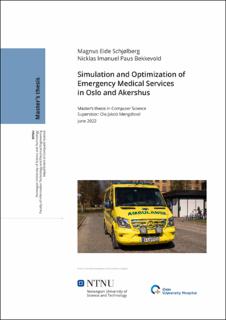| dc.contributor.advisor | Mengshoel, Ole Jakob | |
| dc.contributor.author | Schjølberg, Magnus Eide | |
| dc.contributor.author | Bekkevold, Nicklas Imanuel Paus | |
| dc.date.accessioned | 2022-09-20T17:20:48Z | |
| dc.date.available | 2022-09-20T17:20:48Z | |
| dc.date.issued | 2022 | |
| dc.identifier | no.ntnu:inspera:112046434:30373291 | |
| dc.identifier.uri | https://hdl.handle.net/11250/3019904 | |
| dc.description.abstract | Hvert år øker antallet akutthendelser som håndteres av akuttmedisinsk kommunikasjonssentral i Oslo og Akershus. Dessverre møtes ikke den økende etterspørselen etter prehospitale tjenester av en tilsvarende økning i tilbudet, noe som fører til økt press på de ansatte.
Denne oppgaven har som mål å løse noen av disse utfordringene ved å optimalisere allerede eksisterende ressurser, kjent innen operasjonsanalyse som ambulanseallokering. For denne oppgaven er det lånt ut et datasett som inneholder akutthendelser fra årene 2015 til 2019 i Oslo og Akershus. Hovedbidraget til denne oppgaven er en diskret og sporbasert simulasjonssmodell basert på datasettet. De gjennomsnittlige responstidene som rapporteres fra denne simulasjonsmodellen blir deretter brukt til å evaluere et gitt sett med ambulanseallokeringer og måle deres egnethet. Dette brukes i kombinasjon med heuristiske optimaliseringsalgoritmer fra feltet kunstig intelligens, bestående av en genetisk algoritme, stokastisk lokalt søk og en memetisk algoritme, for å finne optimale ambulanseallokeringer. For å evaluere ytelsen til disse algoritmene så testes disse i tillegg opp mot flere enkle allokeringsmodeller. De ulike modellene sammenlignes deretter mot hverandre over ulike tidsperioder, og simuleringen testes med en rekke ulike scenarier med varierende antall ambulanser, for å prøve å finne et optimalt antall tilgjengelige ambulanser for å betjene tidskritiske hendelser.
Oppgaven presenterer også en gjennomgang av relevant litteratur, samt forslag til fremtidig arbeid som kan bidra til dette forskningsfeltet. | |
| dc.description.abstract | Every year, the number of emergency cases handled by the Emergency Medical Communication Centre in Oslo and Akershus increases. Unfortunately, the increasing demand for prehospital services is not met by a corresponding increase in supply, leading to an increased pressure on the workforce.
This thesis aims to solve some of these challenges by optimizing already existing resources, known in the area of operational research as ambulance allocation. For this purpose, a real-world data set containing emergency events from the years 2015–2019 in Oslo and Akershus has been lent to the authors. The main contribution of this thesis is a discrete and trace-based simulation model based on the data set, with the resulting average response times used to evaluate a given set of ambulance allocations and their performance. In addition, heuristic optimization algorithms from the field of artificial intelligence, consisting of a genetic algorithm, stochastic local search, and a memetic algorithm, are used with this simulation model to find optimal ambulance allocations, testing against a set of baseline allocation models. The various models are then compared against each other over various time periods, and the simulation is tested with a number of different scenarios with varying numbers of ambulances, to try to find an optimal number of available ambulances to serve time-critical incidents.
The thesis also presents a review of relevant literature, as well as suggestions for future work that can help improve upon the current state-of-the-art. | |
| dc.language | eng | |
| dc.publisher | NTNU | |
| dc.title | Simulation and Optimization of Emergency Medical Services in Oslo and Akershus | |
| dc.type | Master thesis | |
